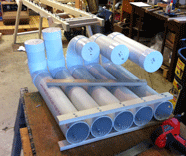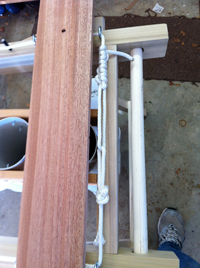Frequently Asked Questions about How to Make Your Own Marimba
1. How do I make measurements for the bars and frame if all the specifications are metric? What kind of hardwood should I use for the tone bars?
Buy a tape or ruler that has both metric and American measurements.
Download the converted English Measurements for Bass Marimba tone bars and frame lumber (Cut list)
Download the Aussie parts list for the local hardware store.
I've had the best success with Cherry. I've tried Oak, Maple, and Mahogony with limited success. The Maple and Oak are a little hard to work with and Mahogany has a tendency to split or crack over time. I've replaced many bars. Cherry has proven to be the right combination of workability and durability. It's not too expensive, just don't ask for "clear" Cherry.
2. What is the American equivalent of "Downpipe" for the resonator tubes?
Look for PVC Schedule 20, Storm and Drain pipe. This is the thin walled PVC NOT the thick walled Schedule 40. The Schedule 40 is very heavy and adds a lot of unnecessary weight.
3. What if I can't find the U-Bend PVC pipe fitting for the Bass Module?
Try and find a 4" White PVC S&D 90D Elbow at a plumbing store or hardware supply outlet. Couple the 90 D Elbow with a 4" PVC Elbow hubxhub. The resonator pipes will end up being a little shorter than the measurements in the book. Just cut them to the written measurements and then tune carefully. Remember to tune them to A = 443.
3a. Does the use of these Elbows affect the tuning? If so how do I adjust?
I've found that the following lengths for the 4" pipes work very nicely with the above PVC elbows:
- Low C - 600 mm - Both Elbows - 393 mm- cap
- Low D - 600 mm - Both Elbows - 260 mm- cap
- Low E - 600 mm - Both Elbows - 150 mm - cap
- Low F# - 600 mm - One PVC Elbow hub x hub - 210 mm - cap
- Low G - 600 mm - One PVC Elbow hub x hub - 150 mm - cap

3b. Are there adjustments that I need to be aware of for the Aussie resonator pipes?
Yes. I've found that the following lengths are appropriate and account for the difference in American and Australian PVC pipes for the Aussie. These lengths work best with the rounded 2" end caps. Add 10 mm to each length if you want to use Flat end caps: (You can download this information as a pdf here.)
- C 600 mm - cap
- D 530 mm - cap
- E 465 mm - cap
- F# 410 mm - cap
- G 385 mm - cap
- A 345 mm - cap
- B 305 mm - cap
- C' 285 mm - cap
- D' 245 mm - cap
- E' 205 mm - cap
- F# 180 mm - cap
- G' 170 mm - cap
- A' 145 mm - cap
- B 125 mm - cap
(1 1/2" Pipe)
- D'' 126 mm - cap
- E'' 105 mm - cap
- F#'' 90 mm - cap
- G'' 80 mm - cap
- A'' 65 mm - cap
4. What are bullet head nails?
8p finish nails. I've found that 8p common nails work well also. You can buy vinyl tubing, black or clear, to use as a bushing. This holds the bars securely while still allowing them to vibrate freely. You'll need to drill the holes in each bar a little larger to accomodate the head of the common nail. Bushings are not necessary but can keep the bars from rattling against the nail.
5. What size screws can I use to fasten the tube resonators to the wooden supports?
Use 1 1/2" self-drilling hex head screws. You can use an attachment on your electric drill to make quick work of these.
6. What can I use for mallets if the large O rings or shock absorber bushes are too hard to find or too expensive?
I've found that Bass mallets from American Drum (P31) or the natural rubber Walt Hampton signature mallets (P32) get the best sound from the bass marimba. Medium rubber mallets (P12) from American Drum do quite well on the 3 1/2 octave marimba and the mini's. For the upper registers and smaller mini's, get the hard rubber mallets (P13) from American Drum. Tom Bourne Mallets are equally good and more authentic to the Marimba playing styles of Zimbabwean mallet music. All of these are reasonably priced.
7. What if my bars get out of tune?
If a marimba or xylophone bar is out of tune it is not difficult to restore it to the correct pitch. Chiselling or rasping (or even sawing) under the middle of a tone-bar will deepen its pitch. Removing wood from the ends will raise the pitch. If the bars are cracked or split, they will need to be replaced. If your marimba has bars suspended on rope, make sure the rope is not sitting on the wood frame. Tighten the rope if necessary.
8. How can I tell if my resonator pipes need to be tuned?
You can check the tuning of a pipe resonator by tapping on the cap while holding a chromatic tuner near the open end of the pipe. If the tube is flat, remove the tube from the frame and shave just a little off the open top. Continue checking the pitch with the chromatic tuner. If the tube is sharp, you'll need to make an open endcap for it with at least half of the cap cut away. The size of the opening can be adjusted as the pitch is checked with the tuner.
9. To address the following issues, please refer to p. 40 in the book:
- Buzzer doesn't work.
- Bars jump off when played.
- Bar is sharp or flat
- Bar is still flat
- Resonation isn't occurring.
10. What is a "quad"?
This refers to a piece of quarter round lumber used to install the baffles in the box resonated marimbas.
11. On page 29, Jon refers to a "reef knot." What does that look like?

Secure Online Ordering
All major credit cards - no PayPal account necessary!
Use your existing PayPal account. To order by email, click here.
 |

